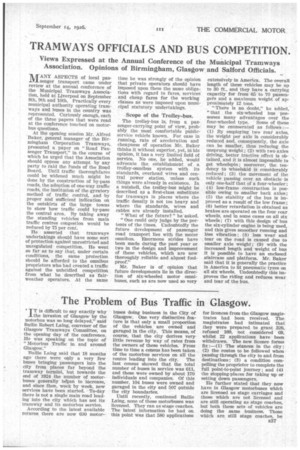TRAMWAYS OFFICIALS AND BUS COMPETITION.
Page 55

If you've noticed an error in this article please click here to report it so we can fix it.
Views Expressed at the Annual Conference of the Municipal Tramways Association. Opinions of Birmingham, Glasgow and Salford Officials.
MANY ASPECTS of local passenger transport came under review at the annual conference of the Municipal Tramways Association, held at Liverpool on September 8th, 9th and 10th. Practically every municipal authority operating tramways and buses in the country was represented. Curiously enough, each of the three papers that were read at the conference touched on motorbus questions.
At the opening session Mr. Alfred Baker, general manager of the Birmingham Corporation Tramways, presented a paper on "Road Passenger Transport," in the course of which he urged that the Association should oppose any attempt by any party to raid the funds of the Road Board. Until traffic thoroughfares could be widened much might be done by the construction of by-pass roads, the adoption of one-way traffic roads, the institution of the gyratory method of traffic control, and by proper and sufficient indication on the outskirts of the large towns to show how traffic could by-pass the central area. By taking away the standing vehicles from main traffic centres congestion would be reduced by 75 per cent.
He asserted that tramways undertakings should have some sort of protection against unrestricted and unregulated competition. He went so far as to say that, under certain conditions, the same protection should be afforded to the omnibus proprietors who had created a traffic against the unbridled competition from what he described as fairweather operators. At the same time he was strongly of the opinion that private operators should have imposed upon them the same obligations with regard to fares, services and cheap fares for the working classes as were imposed upon municipal statutory undertakings.
Scope of the Trolley-bus.
The trolley-bus is, from a passenger-carrying point of view, probably the most comfortable publicservice vehicle known. For ease in running, rate of acceleration and cheapness of operation Mr. Baker thinks it without superior, yet, in his opinion, it has a very limited field of service. No one, he added, would advocate the establishment of a trolley-omnibus system with its standards, overhead wires and central power station, unless such things were already in existence. In a nutshell, the trolley-bus might be described as a first-class substitute for tramways in places where the traffic density is not too heavy and where the standards, wires and cables are already installed.
"What of the future?" he 'asked.
"One could only judge by the portents of the times. Undoubtedly the future development of passenger road transport lies with the motor omnibus. Enormous strides have been made during the past year or two in the design and improvement of these vehicles, which are now thoroughly reliable and abpost foolproof."
Mr. Baker is of opinion that future developments lie in the direction of six-wheeled motor omnibuses, such as are now used so very extensively in America. The overall length of these vehicles may be up to 30 ft., and they have a carrying capacity for from 65 to 70 passengers and a maximum weight of approximately 12 tons.
"There is no doubt," he added, "that the six-wheeled bus possesses many advantages over the four-wheeled type. Some of these may be enumerated as follows :—• (1) By employing two rear axles, the weight per axle is considerably reduced and, consequently, the axle can be smaller, thus reducing the unsprung weight ; (2) with two axles driving, better tractive effect is obtained, and it is almost impossible to get vvheelspin; moreover, the tendency to wheelskid is considerably reduced ; (3) the movement of the vehicle passing over an obstacle is only one-half that of a four-wheeler ;
(4) low-frame construction is possible owing to smaller back axles; (5) the stability of the bus is improved as a result of the low frame ;
(6) better retardation is obtained as brakes are operated on the four rear wheels, and in some eases on all six wheels; (7) with this design of bus the six-cylinder engine is being used, and this gives smoother running and less vibration; (8) less wear and tear on the road is caused due to smaller axle weight ; (D) with the increased length and weight of bus It is possible to have an enclosed staircase and platform. Mr. Baker said that it is generally the practice in America to fit pneumatic tyres on all six wheels. Undoubtedly this improves the riding and reduces wear and tear of the bus.




































































































